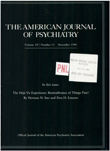Deficit and nondeficit forms of schizophrenia: the concept
Abstract
The authors provide a rationale for distinguishing the primary, enduring negative symptoms of schizophrenia (termed "deficit symptoms") from the more transient negative symptoms secondary to other factors. They argue that the former are more likely to provide a basis for meaningful subtyping of the schizophrenic syndrome, while the latter are more likely to respond to currently available treatments. They describe their experience in using clinical judgment based on longitudinal observations to identify deficit and nondeficit subtypes of schizophrenic patients and propose criteria for defining schizophrenia with the deficit syndrome.
Access content
To read the fulltext, please use one of the options below to sign in or purchase access.- Personal login
- Institutional Login
- Sign in via OpenAthens
- Register for access
-
Please login/register if you wish to pair your device and check access availability.
Not a subscriber?
PsychiatryOnline subscription options offer access to the DSM-5 library, books, journals, CME, and patient resources. This all-in-one virtual library provides psychiatrists and mental health professionals with key resources for diagnosis, treatment, research, and professional development.
Need more help? PsychiatryOnline Customer Service may be reached by emailing [email protected] or by calling 800-368-5777 (in the U.S.) or 703-907-7322 (outside the U.S.).



